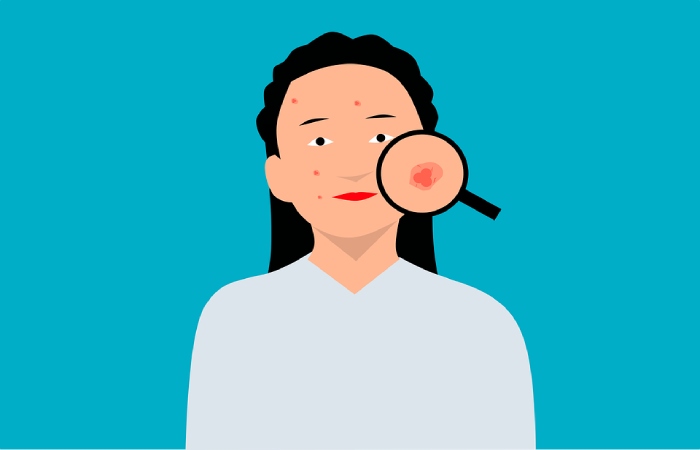Table of Contents
Definition of Whitehead
A whitehead is a type of acne that forms when dead skin cells, oil, and bacteria become trapped within one of your pores. Whiteheads can be annoying, and they may seem to develop at the worst times. The good news is that whiteheads can be prevented with a combination of lifestyle changes and medical treatments.
Fast Facts on Whitehead
Approximately 80 percent of people in the U.S. have reportedly had acne at some point.
Hormonal changes can result in acne, though the link is unclear.
Other causes include perspiration and reactions to certain skincare products and fabrics.
Gently washing the skin twice a day with mild soap and lukewarm water can help.
Types of Whitehead and How to Treat Them
Whiteheads develop when dead skin cells, sebum, and dirt clog your pores. Unlike blackheads, which can be pushed out, whiteheads are closed within the pore. This can make treatment a bit more challenging. Still, there’s hope when it comes to getting rid of pesky whiteheads.
From home and natural remedies to over-the-counter and prescription treatments, you can take a variety of approaches. Read on to learn more about the 12 best ways to get rid of whiteheads.
Home Remedies for Whitehead
Home remedies are perhaps the most accessible and most affordable whitehead removal options. They usually involve using things you may already have around the house. Beware of potentially harmful ingredients, though. It would help if you also stopped any remedy that causes skin irritation.
While some home remedies help, other items can irritate the skin. For example:
apple cider vinegar or lemon juice may be too acidic for sensitive skin
baking soda is too harsh
sugar crystals can worsen inflammation and even cut the skin
Natural Remedies of Whitehead

Natural remedies are increasing in popularity as alternative skin treatments. While the term “natural” seems promising, the downside to these treatments is that they may not go through the same testing standards. Use the following items with caution.
Vitamin A cream
Vitamin A is a nutrient with powerful antioxidant properties. In terms of skin health, vitamin A can decrease redness and inflammation while promoting healthy cell growth.
Some creams sold over the counter and in natural health stores contain vitamin A. These are applied directly to your face once or twice per day. Vitamin A products can cause redness and sensitivity to the sun. You should always wear a daily sunblock when using these products.
Tea tree oil
Tea tree oil is touted as a natural anti-inflammatory. It may also have antimicrobial benefits. These effects mean tea tree oil could help clear up whiteheads.
The oil may be available as an extract you pat directly onto the face. Certain skincare items, such as cleansers, masks, and spot treatments, also contain tea tree oil.
Aloe vera
Aloe vera is another plant-based ingredient. Like tea tree oil, aloe vera is available as an extract or OTC skincare products. Although studies on the efficacy of aloe vera alone are inconclusive, the Mayo Clinic reports that the ingredient may be helpful when used with other acne products.
How Simple is each Type of Whitehead?
Blackheads and whiteheads are the mildest forms of acne. These can sometimes be cleared up with OTC topical medications, such as salicylic acid-based toners or benzoyl-peroxide spot treatments. If they don’t respond to OTC medications, come-ons are easily treated with topical retinoids. Even one type of retinoid, known as adapalene, is now available over the counter. It’s very effective in clearing blackheads and whiteheads.
Pustules and papules are more moderate forms of acne. These may or may not clear up with OTC meds. Widespread mild acne may require an oral or topical prescription from a dermatologist.
Nodules and cysts are the most severe form of acne. Picking or popping nodules and cysts can lead to scars. You have to see a dermatologist to clear up severe acne.
Practical Self-care Tips for Whiteheads
The following strategies can help to treat and prevent acne breakouts:
- washing the skin gently with mild soap and lukewarm water twice a day
- refraining from squeezing pimples or touching the skin unnecessarily
- using caution when shaving
- avoiding excessive sun exposure that could cause tanning or burns
- using only oil-free, non-comedogenic skincare products, which do not clog the pores
- using cosmetics sparingly
- removing makeup before going to bed
- using fragrance-free, water-based, emollient products to treat dry skin
- regularly washing the hair and keeping hairspray away from the face
- wearing loose clothing made of non-synthetic fabrics, such as cotton
- Acne can cause long-term scarring and emotional distress. Anyone concerned about their acne should seek the help of a medical professional or dermatologist, as there may be a treatable underlying health issue.
Conclusion
Some factors can increase the chance of developing blackheads. Age and hormonal changes are important factors. Like other symptoms of acne, blackheads are most common during puberty, when the change in hormone levels triggers a spike in sebum production. However, they can appear at any age.
Androgen, the male sex hormone, triggers the greater secretion of sebum and a higher turnover of skin cells around puberty. Both boys and girls experience higher levels of androgens during adolescence.
After puberty, hormonal changes related to menstruation, pregnancy, and birth control pills can also bring blackheads in women.
